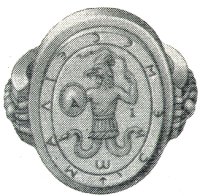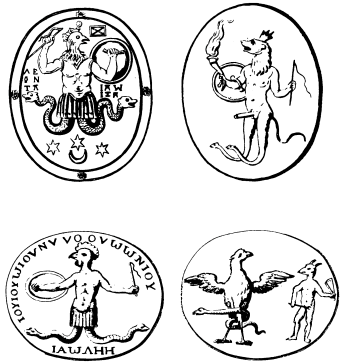 door willy » do 20 jul , 2006 10:32
door willy » do 20 jul , 2006 10:32
Metatron : (Metratton, Mittron, Metaraon, Merraton, etc.)—in noncanonical writings, Metatron is perhaps the greatest of all the heavenly hierarchs, the 1st (as also the last) of the 10 archangels of the Briatic world. He has been called king of angels, prince of the divine face or presence, chancellor of Heaven, angel of the covenant, chief of the ministering angels, and the lesser YHWH (the tetragrammaton). He is charged with the sustenance of mankind. In Talmud and Targum, Metatron is the link between the human and divine.
In his earthly incarnation he was the patriarch Enoch—although Tanhuna Genesis [Rf. Jewish Encyclopedia I, 94] claims he was originally Michael. Talmudic authorities for the most part shy away from identifying Enoch with Metatron; on the contrary, the tendency is to play down the relationship and even to suppress it. In a curious tale of the marriage of God and Earth (Elohim and Edem), told in the Alphabet of Ben Sira, God demands from Earth the "loan" of Adam for 1,000 years. Upon Earth agreeing to the loan, God writes out a formal receipt, and this is witnessed by the archangels Michael and Gabriel.
The receipt, so the story goes, is on deposit "to this day" in the archives of Metatron, the heavenly scribe. Metatron has been variously identified as the dark angel who wrestled with Jacob at Peniel (Genesis 32); as the watchman is "Watch-man, what of the night?" (Isaiah 21); as the Logos; as Uriel; and even as the evil Sammael. It is said that (Exodus 23:20) refers to Metatron : "Behold, I send an angel before thee, to keep thee in the way and to bring thee unto the place which I have prepared" (usually applied to John the Baptist), and (Exodus 23:22) : "My name is in him." In addition, Metatron has been identified as the Liberating Angel and the Shekinah (who is regarded in some sources as Metatron in his female aspect); in Trachtenberg, Jewish Magie and Superstition (p. 76), he is the "demiurge of classical Jewish mysticism."
According to the cabala, Metatron is the angel who led the children of Israël through the wilderness after the Exodus; in other occult writings he is described as the twin brother or half-brother of the angel Sandalphon (cf. the twin brothers Ormuzd and Ahriman in Zoroastrian lore). With the possible exception of Anafiel (q.v.), Metatron is the tallest angel in Heaven, and the greatest, apart from the "eight great princes, the honored and revered ones, who are called YHWH by the name of their king." This is according to 3 Enoch.
Jewish legend relates that upon Metatron (while still Enoch, a mortal) arriving in Heaven, he was transformed into a spirit of fire and equipped with 36 pairs of wings as well as innumerable eyes. The meaning of the name Metatron has never been satisfactorily explained. Eleazor of Worms thought it derived from the Latin metator, a guide or measurer. Hugo Odeberg advanced the hypothesis (3 Enoch, append. 2) that the name Metatron originated in Jewish circles and "should be regarded as a pure Jewish invention, viz., a metonym for the term “little YHWH.” " Odeberg is inclined to interpret the name as meaning "one who occupies the throne next to the divinc throne." Accordingly Metatron is said to reside in the 7th Heaven (the dwelling place of God). He appears, when invoked, "as a pillar of fire, his face more dazzling than the sun." Gershom Scholem, on the basis of The Apocalypse of Abraham, believes the name might be a "vox mystica" for Yahoel (i.e., God).
Metatron has also been identified as Isaiah's suffering servant, the Messiah of Christian theology; but see Orlinsky, "The So-Called “Suffering Servant” in (Isaiah 53)." The 72 names of God find a match in the 72 (and more) names of Metatron—Surya, Tatriel, Sasnigiel, Lad, Yofiel, to mention a few. Metatron has also been credited with the authorship of (Psalms 37:25) according to Talmud Yebamoth 16b; and the authorship, in part, of (Isaiah 24:16). In The Zohar I, Metatron is spoken of as Moses' rod, "from one side of which comes life and from the other, death."
In Eisenmenger, Traditions of the Jews II, 408, Metatron is indeed the supreme angel of death, to whom God daily gives orders as to the souls to be "taken" that day. These orders Metatron transmits to his subordinates Gabriel and Sammael. That Metatron was considered, at least in some sources, mightier than either Michael or Gabriel is the view expressed in the Chronicles of Jerahmeel. Here the story goes that whereas neither of the two great Biblical angels was able to eject Jannes and Jambres, the Egyptian wizards, from Heaven (whither they managed, it seems, to ascend by witchcraft), Metatron was able to accomplish their expulsion. In Yalkut Hadash, also, Metatron is said to be "appointed over Michael and Gabriel."
As for the size or height of Metatron, The Zohar computes it to be "equal to the breadth of the whole world." In rabbinic lore, this was the size of Adam before he sinned. One of Metatron's secret names is Bizbul (according to the Visions of Ezekiel where, however, the meaning of this name is not given). King, The Gnostics and Their Remains, p. 15, says of Metatron : "This is the Persian Mithra." Many other sources, supporting this identification, are cited by Odeberg, 3 Enoch. In Jewish angelology, Metatron is "the angel who caused another angel to announce, before the Flood, that God would destroy the world." [Rf. Jewish Encyclopedia, "Metatron," vol. 8.] Among numerous other missions or deeds credited to Metatron is the staying of Abraham's hand on the point of sacrificing Isaac. But this 11th-hour intercession has also been imputed to Michael, Zadkiel, Tadhiel, and of course to the "angel of the Lord," who is the one designated in (Genesis 22). Finally, according to Talmud Abodah Zarah 3b, Metatron is the "teacher of prematurely dead children in Paradise."
Davidson, Gustav : A Dictionary of Angels, blz. 192-193.









